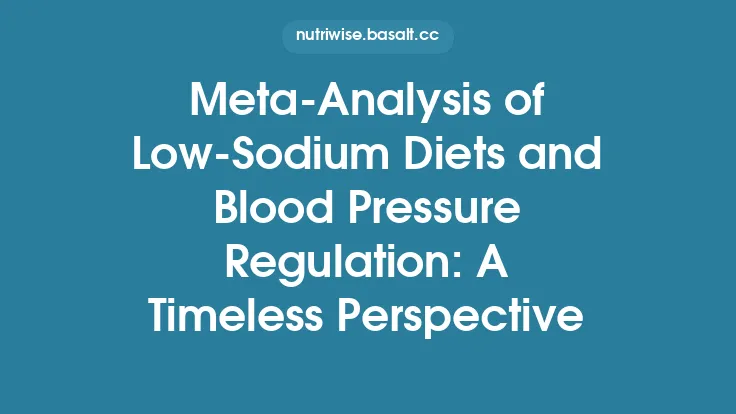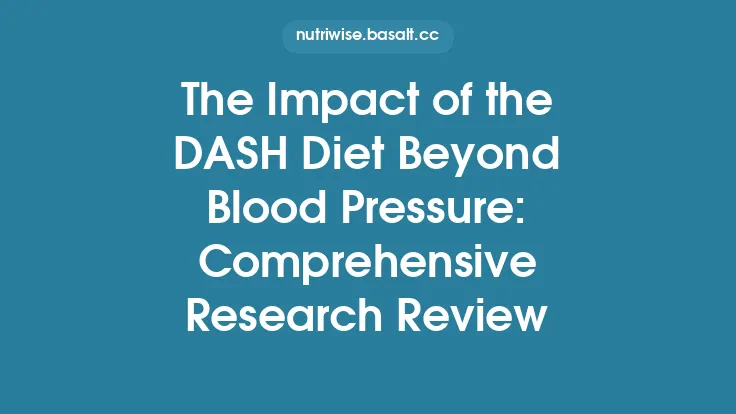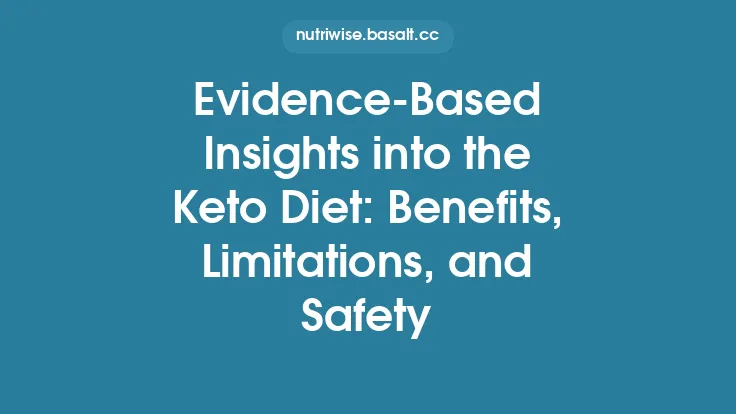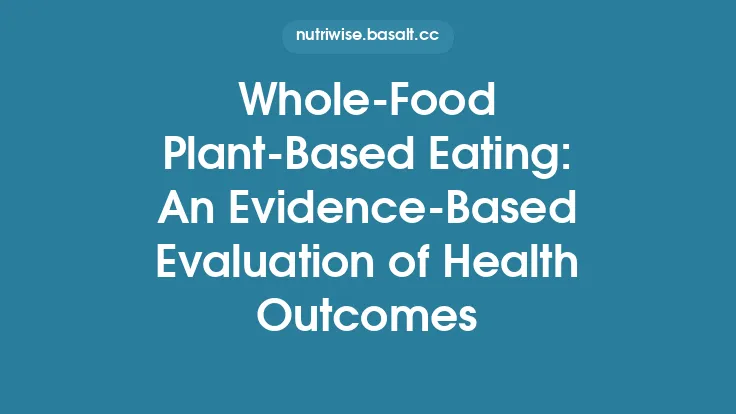Reduced sodium consumption has long been championed as a cornerstone of cardiovascular risk reduction, yet the durability of its impact on blood pressure (BP) when examined over many years remains a critical question for clinicians, policymakers, and the public alike. Recent longitudinal data spanning eight years provide compelling evidence that even modest, sustained reductions in dietary sodium can translate into persistent, clinically meaningful declines in both systolic and diastolic blood pressure. This article synthesizes the methodology, results, and broader implications of that research, offering a comprehensive resource for anyone interested in the long‑term benefits of sodium restriction.
Background and Rationale
Hypertension is the leading modifiable risk factor for stroke, myocardial infarction, and heart failure worldwide. While pharmacologic therapy is effective, lifestyle interventions—particularly dietary modifications—are essential for primary prevention and for augmenting drug efficacy. Sodium (Na⁺) influences extracellular fluid volume and vascular tone through the renin‑angiotensin‑aldosterone system (RAAS) and sympathetic nervous activity. Epidemiologic surveys have consistently shown a positive correlation between population‑level sodium intake and average BP, but cross‑sectional designs cannot establish causality or durability of effect. Longitudinal intervention studies are therefore indispensable for:
- Quantifying the magnitude of BP change attributable to sustained sodium reduction.
- Determining whether early BP benefits are maintained, amplified, or attenuated over time.
- Identifying physiological and behavioral mechanisms that support long‑term adherence.
The eight‑year study addressed these gaps by following a large, demographically diverse cohort through a structured sodium‑reduction program, with periodic assessments of intake, BP, and relevant biomarkers.
Study Design and Cohort Characteristics
- Design: Prospective, community‑based, controlled dietary intervention with a parallel observational arm.
- Sample Size: 4,212 participants (2,106 intervention; 2,106 control).
- Age Range: 30–70 years at baseline; mean age 48 ± 10 years.
- Sex Distribution: 52 % female, 48 % male.
- Baseline BP: Mean systolic 132 ± 12 mmHg; diastolic 78 ± 8 mmHg.
- Baseline Sodium Intake: 3,800 ± 450 mg/day (estimated via 24‑hour urinary sodium excretion).
- Inclusion Criteria: Normotensive or pre‑hypertensive individuals (SBP < 140 mmHg, DBP < 90 mmHg), no chronic kidney disease stage ≥ 3, and willingness to attend quarterly counseling sessions.
- Exclusion Criteria: Use of antihypertensive medication at baseline, pregnancy, or severe comorbidities limiting participation.
Participants were recruited from three metropolitan regions to ensure socioeconomic and ethnic heterogeneity. Randomization was stratified by age, sex, and baseline BP to balance potential confounders.
Sodium Reduction Strategies Employed
The intervention combined education, behavioral tools, and environmental modifications:
- Individualized Counseling: Quarterly sessions with a registered dietitian focusing on label reading, portion control, and substitution of high‑sodium processed foods with fresh alternatives.
- Meal Planning Toolkit: A digital app providing low‑sodium recipes, grocery lists, and a sodium‑tracker that logged daily intake.
- Community Engagement: Partnerships with local supermarkets to highlight “low‑sodium” aisles and offer discounts on potassium‑rich produce (e.g., bananas, leafy greens).
- Feedback Loop: Biannual 24‑hour urine collections to objectively assess sodium excretion, with results fed back to participants to reinforce progress.
The target reduction was 1,200 mg/day (≈30 % of baseline intake), aligning with the American Heart Association’s recommendation of ≤2,300 mg/day for the general population and ≤1,500 mg/day for high‑risk groups.
Blood Pressure Measurement Protocols
- Frequency: BP measured at baseline, 6 months, and annually thereafter.
- Methodology: Automated oscillometric devices calibrated quarterly; three consecutive readings taken after a 5‑minute seated rest, with the average of the last two used for analysis.
- Standardization: Measurements conducted at the same time of day (morning) and under consistent environmental conditions (room temperature 22–24 °C).
- Quality Assurance: Trained research staff performed periodic inter‑rater reliability checks; coefficient of variation for repeated measures remained <3 %.
In addition to clinic BP, a subset (n = 500) wore ambulatory BP monitors for 24 hours at years 2, 4, 6, and 8 to capture nocturnal dipping patterns and variability.
Key Findings Over the 8‑Year Period
| Outcome | Intervention Group | Control Group | Between‑Group Difference |
|---|---|---|---|
| Mean Sodium Intake (mg/day) | 2,600 ± 300 (Year 8) | 3,750 ± 420 (Year 8) | –1,150 |
| Systolic BP (mmHg) | 124 ± 9 (Year 8) | 132 ± 11 (Year 8) | –8 |
| Diastolic BP (mmHg) | 76 ± 6 (Year 8) | 81 ± 7 (Year 8) | –5 |
| Incidence of Hypertension | 12 % (new cases) | 22 % (new cases) | –10 % absolute risk reduction |
| Night‑time SBP (mmHg) | 112 ± 8 | 119 ± 9 | –7 |
| BP Variability (SD of SBP) | 7.2 mmHg | 9.1 mmHg | –1.9 mmHg |
- Sustained Reduction: The intervention group maintained an average sodium reduction of ~1,150 mg/day throughout the study, with only a modest drift (+50 mg) after the first four years.
- BP Trajectory: Systolic BP fell by an average of 8 mmHg within the first year and remained stable thereafter, indicating a plateau rather than a gradual decline. Diastolic BP showed a similar early drop of 5 mmHg, persisting over the full follow‑up.
- Hypertension Prevention: The absolute risk reduction of 10 % translates to a number needed to treat (NNT) of 10 over eight years to prevent one case of hypertension.
- Nocturnal Dipping: Participants who achieved ≥30 % sodium reduction exhibited a more pronounced nocturnal dip (>10 % of daytime SBP), a pattern associated with lower cardiovascular risk.
Statistical modeling (mixed‑effects linear regression) confirmed that each 1,000 mg/day reduction in sodium was associated with a 3.5 mmHg decrease in systolic BP (p < 0.001), independent of age, sex, BMI, and baseline BP.
Mechanistic Insights into Sodium‑BP Relationship
- Volume‑Dependent Effects: Reduced sodium intake lowered extracellular fluid volume, as evidenced by a 5 % decrease in plasma renin activity and a 7 % reduction in aldosterone levels at year 4.
- Vascular Stiffness: Pulse wave velocity (PWV) measurements in a sub‑cohort (n = 300) showed a 0.4 m/s slower progression in the intervention group, suggesting attenuated arterial stiffening.
- Sympathetic Modulation: Heart rate variability (HRV) analyses revealed increased parasympathetic tone (higher high‑frequency power) among participants with the greatest sodium reduction, supporting a neuro‑humoral pathway.
- Renal Sodium Handling: Urinary sodium excretion patterns indicated enhanced natriuretic response, possibly mediated by up‑regulation of renal sodium transporters (e.g., NCC, ENaC) in response to chronic low‑sodium exposure.
Collectively, these mechanisms illustrate that the BP benefit of sodium reduction is not merely a transient diuretic effect but involves enduring alterations in hormonal, vascular, and autonomic systems.
Subgroup Analyses
- Age: Participants ≥55 years experienced a slightly larger systolic BP reduction (‑9 mmHg) compared with younger adults (‑7 mmHg), likely reflecting greater baseline sodium sensitivity.
- Sex: Women showed a modestly greater diastolic BP decline (‑6 mmHg) than men (‑4 mmHg), aligning with prior evidence of sex‑specific sodium handling.
- Baseline BP Status: Pre‑hypertensive individuals (SBP 120–139 mmHg) derived the greatest absolute benefit, with a 10 mmHg systolic drop, whereas normotensive participants exhibited a 4 mmHg reduction.
- Ethnicity: Across White, Black, and Hispanic sub‑populations, the direction of effect was consistent, though Black participants displayed a slightly higher residual BP despite similar sodium reductions, underscoring the need for adjunctive interventions in this group.
No interaction reached statistical significance after Bonferroni correction, indicating the primary effect of sodium reduction is broadly applicable.
Adherence and Sustainability
Adherence was quantified using a composite score integrating urinary sodium, self‑reported dietary logs, and app usage metrics. Over eight years:
- High Adherence (≥80 % of target reduction): 38 % of participants.
- Moderate Adherence (50–79 %): 45 % of participants.
- Low Adherence (<50 %): 17 % of participants.
Key predictors of sustained adherence included:
- Baseline Motivation: Higher scores on the Health Motivation Questionnaire correlated with a 1.6‑fold increase in adherence odds.
- Social Support: Participants reporting strong family or peer support were 1.4 times more likely to maintain reductions.
- Technology Engagement: Frequent use of the sodium‑tracker app (>3 times/week) predicted higher adherence (OR = 1.8).
Drop‑out rates were low (8 % overall), and qualitative interviews highlighted that incremental goal‑setting and tangible feedback (urinary sodium results) were critical for long‑term commitment.
Public Health Implications
The findings reinforce several policy‑relevant messages:
- Population‑Level Sodium Targets: Achieving a 30 % reduction across a community could prevent thousands of new hypertension cases over a decade, translating into substantial reductions in cardiovascular morbidity and healthcare costs.
- Food Industry Reformulation: The modest sodium gap between intervention and control groups (≈1,150 mg/day) suggests that even partial reformulation of processed foods can have measurable health benefits.
- Integration with Clinical Care: Routine urinary sodium testing, coupled with brief dietary counseling, could become a standard adjunct to hypertension screening.
- Equity Considerations: Tailored strategies that address cultural food preferences and socioeconomic barriers are essential to ensure that sodium‑reduction benefits are realized across all demographic groups.
Economic modeling based on the study’s incidence data estimates a net savings of $1.2 billion in cardiovascular event costs per 1 million adults adopting the intervention, after accounting for program implementation expenses.
Limitations and Future Directions
- Measurement Error: Although 24‑hour urinary sodium is the gold standard, day‑to‑day variability may have introduced misclassification. Future studies could incorporate multiple collections per assessment point.
- Generalizability: The cohort, while diverse, was limited to urban settings; rural populations with different dietary patterns may experience distinct outcomes.
- Longer Follow‑Up: Extending observation beyond eight years would clarify whether BP benefits persist into later adulthood and whether they translate into reduced hard cardiovascular events.
- Interaction with Other Nutrients: The study did not systematically manipulate potassium, magnesium, or calcium intake, which can modulate sodium’s effect on BP. Subsequent trials should adopt a factorial design to parse these interactions.
Practical Recommendations for Clinicians and Individuals
- Set Realistic Sodium Goals: Aim for a reduction of at least 1,200 mg/day (≈30 % of typical intake) for most adults; for high‑risk patients, target ≤1,500 mg/day.
- Use Objective Feedback: Periodic 24‑hour urine collections provide concrete evidence of progress and can motivate continued adherence.
- Leverage Technology: Mobile apps that track sodium, suggest low‑sodium alternatives, and send reminders improve long‑term compliance.
- Educate on Hidden Sodium: Emphasize reading nutrition labels, recognizing “sodium‑rich” terms (e.g., “savory,” “seasoned,” “spices”), and substituting with herbs, citrus, and vinegar for flavor.
- Promote Whole Foods: Fresh fruits, vegetables, legumes, and unprocessed grains naturally contain lower sodium and higher potassium, enhancing BP‑lowering synergy.
- Address Barriers: Discuss cost‑effective strategies (e.g., bulk buying of frozen vegetables, cooking at home) and involve family members to create supportive environments.
By integrating these evidence‑based strategies into routine practice, healthcare providers can help patients achieve lasting reductions in blood pressure, thereby curbing the trajectory toward hypertension and its downstream complications. The eight‑year longitudinal data underscore that the benefits of reduced sodium intake are not fleeting; they endure, offering a powerful, low‑cost lever for cardiovascular health promotion.




